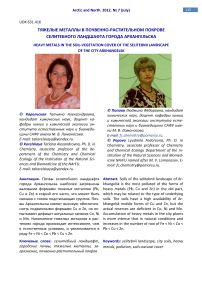Heavy metals in the soil-vegetation cover of the selitebnii landscape of the city Arkhangelsk
Автор: Korelskaya T.A., Popova L.F.
Журнал: Arctic and North @arctic-and-north
Рубрика: Biological Sciences
Статья в выпуске: 7, 2012 года.
Бесплатный доступ
Soils of the selitebnii landscape of Arkhangelsk is the most polluted of the forms of heavy metals (Pb, Cu and Zn) in the old part, which may be related to the type of underlying soils. The soils have a high availability of Arkhangelsk mobile forms of Cu and Zn, but the actual reserves are deficient in Co, Ni and Mn. Accumulation of heavy metals in the city plants is more intense that in natural conditions and increases in the number of row of Fe < Ni < Co < Pb < Cu < Zn.
Selitebnii landscape, city soils, heavy metals, pollution, soils-natural cover
Короткий адрес: https://sciup.org/148320432
IDR: 148320432 | УДК: 631.416
Текст научной статьи Heavy metals in the soil-vegetation cover of the selitebnii landscape of the city Arkhangelsk
Intense process of urbanization has led to a number of environmental problems associated with the sharp deterioration of the urban environment. All this calls for indicating and objective assessment of its present state, especially in the harsh climatic conditions of the North.
A major problem of the large cities is the pollution of heavy metal objects (hereinafter --‐ TM). Especially pollution of urban soils, one of the main components of the biosphere, is that in large cities in a relatively small area comprises a large number of different sources (industry, transport, waste), causing the intensity and heterogeneity of soil contamination.
The supply HM in the soil cover determines whether their further migration to groundwa--‐ ter, availability to plants, a potential threat to living organisms, including humans. However, soil is one of the most important protective, biochemical barriers to a number of compounds to their migration into groundwater and plants. Therefore, the chemical analysis of soil and green areas is a major part of biogeochemical studies urboecosystems. The study of heavy metals in the system "soil --‐ plant" to evaluate the nature of their migration and redistribution, accumulation in the spe--‐ cific organs of plants and soil horizons, to identify structural and functional features of the differ--‐ ent types of soils and plant species in the self--‐purification ability urboecosystems.
Integrated assessment and monitoring of changes in diagnostic performance characteris--‐ tics of land cover that occur under the influence of anthropogenic--‐polluting, will establish the op--‐ timal and critical to maintaining normal functioning urboecosystems and implement timely measures to maintain their stability and recovery.
Therefore, the main aim of the work – is to evaluate the ecological status of land cover res--‐ idential landscape of the city of Arkhangelsk on the extent of contamination by heavy metals, con--‐ sider the patterns of their migration and accumulation in the soil and vegetation urboecosystems of the North.
Objects and methods of the research
The objects of the research are the main types of the urban soils common in the city of Ar--‐ khangelsk: replantozemy, urbanozem, kulturozemy (Figure 1). We select the most common woody plants growing on the respective test areas (birch, willow, poplar), and ground cover plants (herbs mixed sample).
As a control (reference standards) for urban soils and plants was selected natural turf low--‐ power light loamy soils formed on dry meadow near the village Babonegovo Primorsky district of the Arkhangelsk region, and the plants that grow in the area. This choice was dictated by the fact tha ter--‐ ist
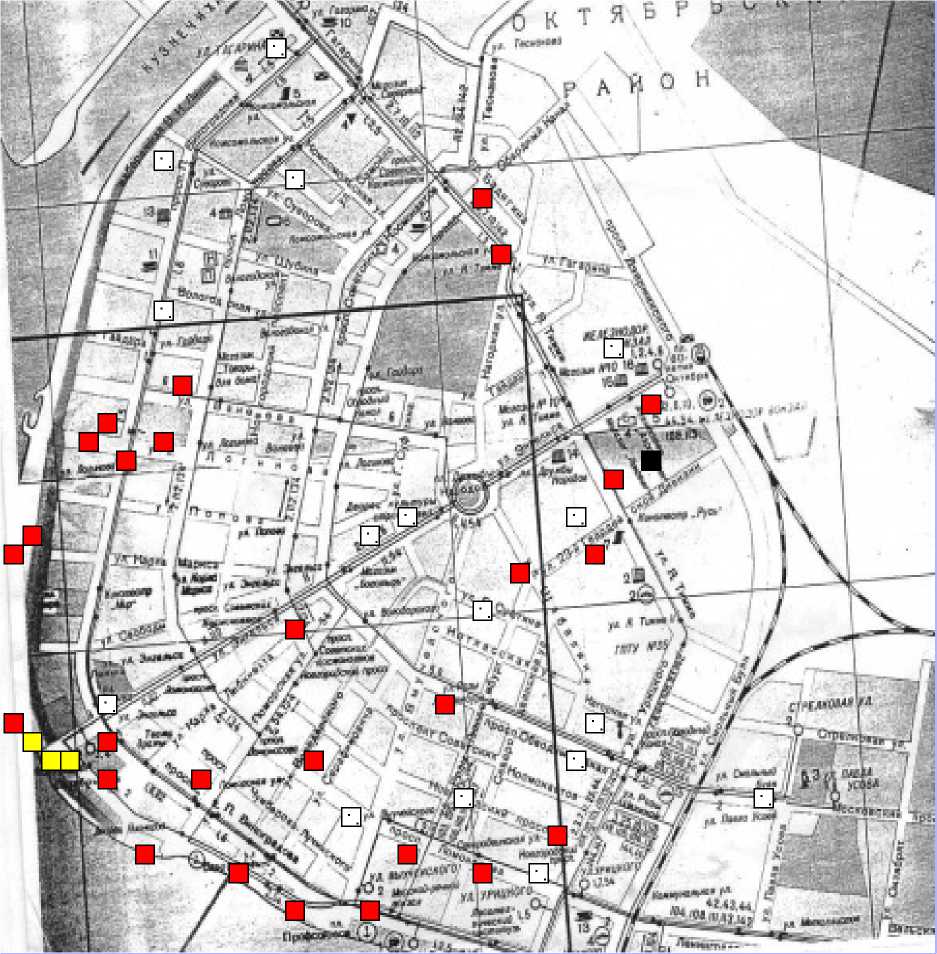
- Urbanozem; - replantozem; - culturozem
Picture 1. The scheme of the residential landscape of the city of Arkhangelsk
In the city in the areas other than the time of the formation of soil, laid 58 plots. With them for the study of the spatial variability of the soil properties of some indicators of the mixed sam--‐ ples were taken from the upper layer (0--‐20 cm) [2, 1984], and in 35 of them laid soil profiles. Their description was performed according to the standard techniques with the recommendations for the study of urban soils [11, 1997]. Selection, storage and transport of samples taken for the anal--‐ ysis on TM, are in accordance with GOST 17.4.4.02--‐84.
In woody plants sampled leaves, branches (the first and second year), bark and roots. The leaves and branches were taken at a height of 1.5--‐2.0 m along the perimeter of the crown. Sam--‐ ples were taken from the bark of several to nearby trees at a height of 1.0--‐1.5 m along the circum--‐ ference of the barrel. Chip thickness of 2--‐3 mm. The trees were selected for sampling as possible even--‐aged, healthy. The content of Pb, Zn, Cu, Hg, Cd in soil and plant samples were determined by atomic absorption method, and Fe, Ni, Co, Mn --‐ colorimetrically. To determine the use of the mobile TM acid (Fe, Ni, Co, Mn, Pb) and ammonium acetate--‐buffer (Cu, Zn) extraction.
The research of the chemical properties was carried out on the samples of the soil and plants in 2--‐5 replicates. These data statistically processed in Excel. To study the structure of the relationship parameters studied using correlation analysis.
Assessment of the level of contamination of the soil and vegetation TM held on the indi--‐ cators developed for the associated biogeochemical studies of the urban environment with the existing sources of pollution. These indicators are the concentration ratio of the chemical (QC) and total pollution index (SDRs) as anthropogenic anomalies often have multi element composition.
Concentration ratio defined as the ratio of the actual content of the analyte in the test point to its content in a similar environment in the background section:
К
к
С i
C ф
where Ci – is the content of the chemical elements in the sampling points; Sf – is the average con--‐ tent of the element in a similar environment in the background section.
Total pollution index represents the excess concentration of the factor chemicals that ac--‐ cumulate in the anomalies. The calculation was performed using the following formula [10, 1990]:
СПЗ = j КС - (n -1), г-1
Where SDR – is the total pollution index; n – is the number of defined ingredients; KSi – is the metal concentration ratio (the ratio of the metal content in the soil anomaly to background con--‐ tent).
Assessment of the soil contamination of TM was performed according to the following grades [6, 1998, 3, 2003]:
СПЗ > 128 – extremely dangerous pollution;
СПЗ = 32–128 – dangerous pollution;
СПЗ = 16–32 – moderate pollution;
СПЗ < 16 – allowable pollution.
К П = СПФ ⋅ 100% ,
ВФ
Where SPF – is the content of the mobile forms of metals in soil, mg / kg; SVF --‐ isthe content of the gross form of the metal in the soil, mg / kg.
To establish the specificity of the species of the plants and their growing influence of the conditions (soil type and its properties) on the absorption intensity biophilic elements and TM was used biogeochemical absorption coefficient (CPP) [12, 2005]:
КБП = С Р , С П where SR – is the element content in plants, mg / kg, PO – is the mobile forms of the element in the soil, mg / kg.
The subtance of the heavy metals in the soils
Determining the level of the soil contamination of Arkhangelsk conducted by analyzing da--‐ ta on the content of the upper layer (0--‐20 cm) of gross forms of TM first class of danger (Lead (Pb), cadmium (Cd), mercury (Hg), and zinc (Zn)), the second class (copper (Cu)) and is calculated on the basis of their total pollution index for the investigated sites.
Estimation of gross content of heavy metals in the surface layer of the soil showed the presence of Arkhangelsk polyelement pollution --‐ in urban soils of average concentrations of chem--‐ ical elements (Cu, Zn, Pb, Hg) higher than for the natural soil (Table 1).
The degree of the excess chemical elements in the urban soils of those in natural soils to evaluate the concentration ratio (Rk) (Figure 2). Concentration factor curves show that replanto--‐ zemah (young soils of the city) is dominated by pollution Pb, in urbanozem --‐ Pb and Hg, and kul--‐ turozemah to these pollutants is added and Zn.
In the soils of the city of Arkhangelsk total content of mercury (Hg) in the upper layer (0--‐20 cm) in most of the test plots and scatter plots are not beyond the scope of MCL (2.1 mg / kg), but kulturozemah urbanozem and its content is much higher than in replantozemah. In some cases, it comes to 4,05--‐4,90 mg / kg, which is 1,9--‐2,3 MACs. The minimum content of total forms of Hg (<0,075 mg / kg) was found in the natural soil, and sand opeschanennyh urbanozem replanto--‐ zemah central city of Arkhangelsk.
Table 1
The average content of total forms of TM (mg / kg) in the urban and natural soils and the maxi--‐ mum permissible concentration (MPC)
|
Chemi--‐ cal el--‐ ement |
Natural soilа n = 2 |
Culturozam n = 2 |
Urbano--‐ zem |
Replantozem |
Urbano--‐ zem UVAO Moscow [8, 2007] |
The soils of Saint Peters--‐ burg [12, 2005] |
The soils of Lenin--‐ grad soils [12, 2005] |
PDK ZINAO, MG/KG |
|
Pb |
14 ± 1,4 |
106 ± 45 |
76 ± 33 (n = 20) |
59 ± 14 (n = 17) |
37 |
223 |
19 |
38 (32*) |
|
Cu |
15 ± 1 |
39 ± 11 |
48 ± 14 (n = 9) |
39 ± 7 (n = 9) |
59 |
120 |
18 |
53 (100**) |
|
Zn |
73 ± 12 |
770 ±2 46 |
149 ± 18 (n = 9) |
109 ± 24 (n = 9) |
208 |
774 |
43 |
87 (300**) |
|
Hg |
< 0,075 |
0,92 ± 0,10 |
0,50 ± 0,08 (n = 9) |
0,15 ± 0,01 (n = 9) |
- |
0,8 |
0,0 |
2,1* (2**) |
|
Cd |
< 1 |
< 1 |
< 1 (n = 9) |
< 1 (n = 9) |
2 |
1,5 |
0,2 |
0,6 (3**) |
|
СПЗ |
- |
30 |
14 |
7 |
- |
- |
- |
- |

Figure 2.The average concentration factor of TM in different types of the soils in Arkhangelsk
Concentration of Cadmium (Cd) in all studied soils less than 1 mg / kg, but in some cases the content of the gross forms of Cd in the soil was 1.2 and 1.6 mg / kg, which is 2--‐2.7 times great--‐ er than its estimated allowable concentration (0.6 mg / kg).
The concentration of total forms of copper (Cu) and zinc (Zn) in the upper layer of urban soils (0--‐20 cm) in different areas varies widely, from 9 to 170 and from 27 to 770 mg / kg, respec--‐ tively. The content of total forms of Cu (53 mg / kg) in the upper layer of soil 25% of plots, of which there are as urbanozem and replantozemy amounted to 1.1--‐3.2 MAC. The content of total Zn ex--‐ ceeds the MCL (87 mg / kg) in 1,1--‐8,8 times more than half of the sites investigated. Maximum values (770 and 238 mg / kg) content of total forms of Zn reached the top layer kulturozema Pe--‐ trovsky Park --‐ the oldest on the duration of human and industrial impact soil and in replantozeme, located near the coast of the Northern Dvina and the railway.
The content of total forms of lead (Pb) in the soil of the city of Arkhangelsk on all study ar--‐ eas than its content in natural soils 1,3--‐73 times, and 55% higher than the MAC plots (38 mg / kg) 1,1--‐27 times.
In general, the evaluation of the concentration of the chemical elements in the soil on a scale of the danger of thecontamination of soil, prepared on the basis of the total magnitude of the pollution (SDR) [10, 1990], identified Contaminant Level (SDRs from 1--‐15 standard units) and urbanozem replantozemov and moderately hazardous (GPA of 16--‐32 conventional units) kultur--‐ ozems.
The top layer of soil on the periphery of the city of Arkhangelsk in more polluted TM (Fig--‐ ures 2, 3, 4). This is historically the central area of the city and part of the landside area (University prospectuses and Dzerzhinsky), where common clay soil and peat replantozemy. The concentric arrangement of the areas of different levels of TM may be related to two factors: age and devel--‐ opment with the underlying soil. In the center of the modern city of Arkhangelsk are peat, reach--‐ ing depths of more than 12 m They provide high migration flows, which is reinforced by dumping sand, often up to 4 m or more, with ongoing construction on peat. On the periphery of the city is a moraine clay, reducing the irrigation of soil and increase the concentration of heavy metals in the surface layers of soil [4, 2000, 5, 2006]. Thus, according to research A. Nikitin, filtration coefficient of natural turf in the center of the city of Arkhangelsk is 2,9--‐5,1 m/day. At the same time, the rate for sandy soils on average 10--‐15 m / day, and for clay --‐ less than 0.001 m/day.
In addition to the assessment of soil contamination by gross forms of TM in soil--‐ geochemical monitoring should focus on the content in the soils of their mobile forms. In this re--‐ gard, we have been evaluated the degree of mobility in soils TM city of Arkhangelsk. The results are shown in Table 2.
Table 2
Content of mobile forms of TM (mg / kg) in the urban and natural soils and maximum permissible concentration (MPC)
|
Ele--‐ ment |
Natural soil n = 2 |
Culturozem n = 2 |
Urbanozem |
Replantozem |
Urbano--‐ zem UVAO Moscow [8, 2007] |
The soils of the Europan part of Russia [12, 2005] |
PDK, MG/KG [7, 1991] |
|
Pb |
0,40 ± 0,05 |
0,80 ± 0,16 |
1,30 ± 0,26 n = 25 |
1,40 ± 0,78 n = 14 |
5,44 |
- |
6,0 |
|
Cu |
1,40 ± 0,25 |
1,80 ± 0,23 |
3,40 ± 0,75 n = 21 |
3,00 ± 1,83 n = 29 |
5,17 |
1,0 – 15,0 |
3,0 |
|
Zn |
4,60 ± 0,92 |
18,60 ± 1,86 |
19,60 ± 2,94 n = 7 |
27,60 ± 6,35 n = 7 |
71,03 |
≤ 3,0 |
23,0 |
|
Fe (г/кг) |
12,60 ± 2,77 |
22,00 ± 2,86 |
16,90 ± 6,25 n = 29 |
12,50 ± 2,51 n = 18 |
- |
- |
- |
|
Ni |
0,20 ± 0,02 |
1,00 ± 0,13 |
1,20 ± 0,53 n = 15 |
0,89 ± 0,64 n = 12 |
2,41 |
- |
4,0 |
|
Co |
0,40 ± 0,04 |
1,70 ± 0,29 |
1,10 ± 0,57 n = 29 |
1,20 ± 0,14 n = 19 |
0,14 |
0,3 – 4,7 |
5,0 |
The content of mobile forms of Pb in all the sites studied did not exceed the MPC (6 mg / kg). However, soils are depleted of mobile forms of cobalt (Co), nickel (Ni) and manganese (Mn), which are not only man--‐made pollutants, but necessary for the plant micronutrients. In kultur--‐ ozems observed maximum concentration of the mobile forms of Fe, Co, Mn, and replantozems --‐ Pb, but most sites investigated the contents well below the MCL.
According to the degree of mobility (R) TM urbanozem replantozem can be arranged in a number of Zn> Cu> Pb, and in natural soils and kulturozem --‐ Cu> Zn> Pb. The greatest mobility da--‐ ta TM possess replantozems, the smallest – is in kulturozems. This trend in the change of the de--‐ gree of mobility of TM due to the fact that Cu and Pb have similar chemical properties and tend to the formation of specific binding to the components of the soil absorbing complex (including the coordination type) and form with humic acids stronger complexes than zinc, which binds non--‐ specifically and more mobile [12, 2005].
The migration of heavy metals in the soils
In addition to determining the level of contamination TM upper 20 cm soil layer of Arkhan--‐ gelsk a study of their distribution on the horizons of soil profiles 25 different types.
Analysis of the data showed that the pollution gross forms of TM (Pb, Cd, Hg, Cu, Zn) for various types of soils in Arkhangelsk, usually has a humus--‐accumulative in nature, that is, the max--‐ imum number is centered on the sorption of biogeochemical barriers in the upper soil layers most rich in humus. Further, it is sharply reduced or changed gradually, depending on the type of pollu--‐ tant, particle size distribution, soil organic matter and availability of other properties. However, this version of the distribution of heavy metals in soils is not only the city of Arkhangelsk. There are sections where the depth is a gradual increase in the content of one or more TM. There may be a maximum of two. The second group were the soil area of modern building (60--‐80s) with a thin profile consisting of horizons light granulometric composition formed on peatlands of differ--‐ ent power.
In natural soils, there are no significant fluctuations of TM on the profile. In addition, in contrast to an increase in urban soils of accumulation with depth. In our opinion, this phenome--‐ non is primarily associated with significantly lower levels of airborne industrial loads, respectively the upper layers of natural soils are more acidic environment than in urban soils.
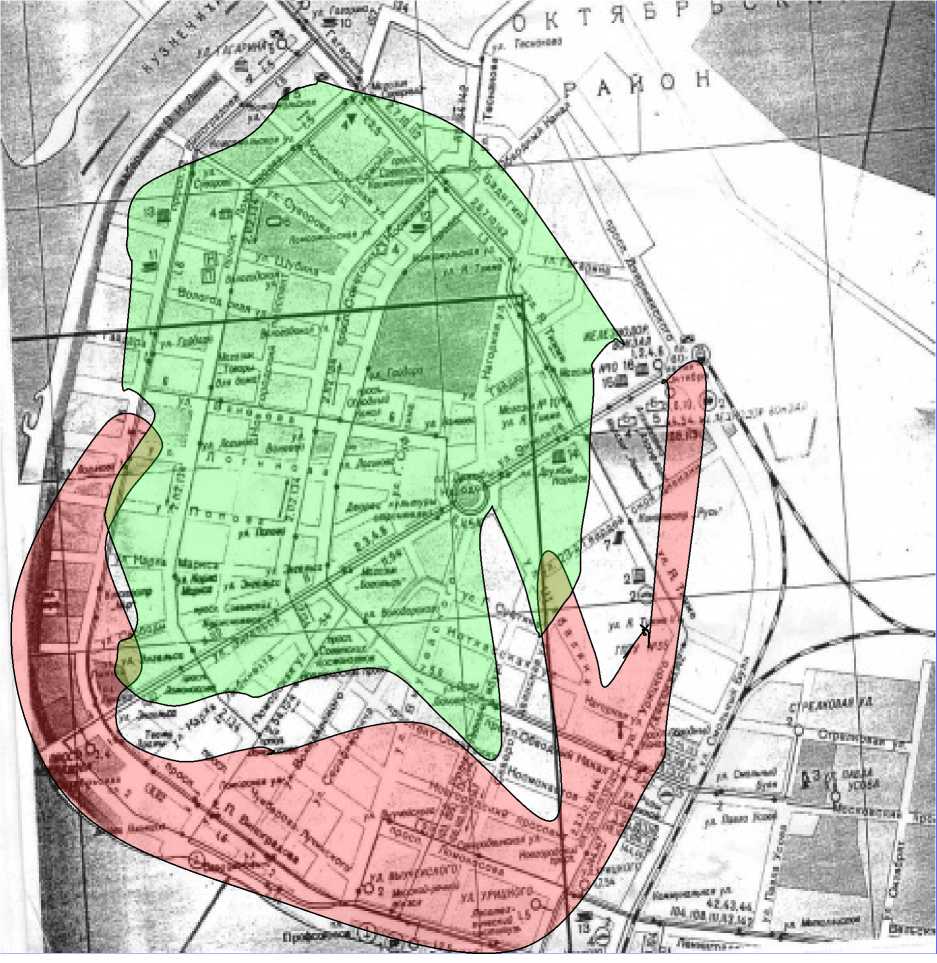
> PDK; [ ।< PDK
Figure 2. The content of total forms of lead in the soils of the city of Arkhangelsk (Pb, mg / kg soil)
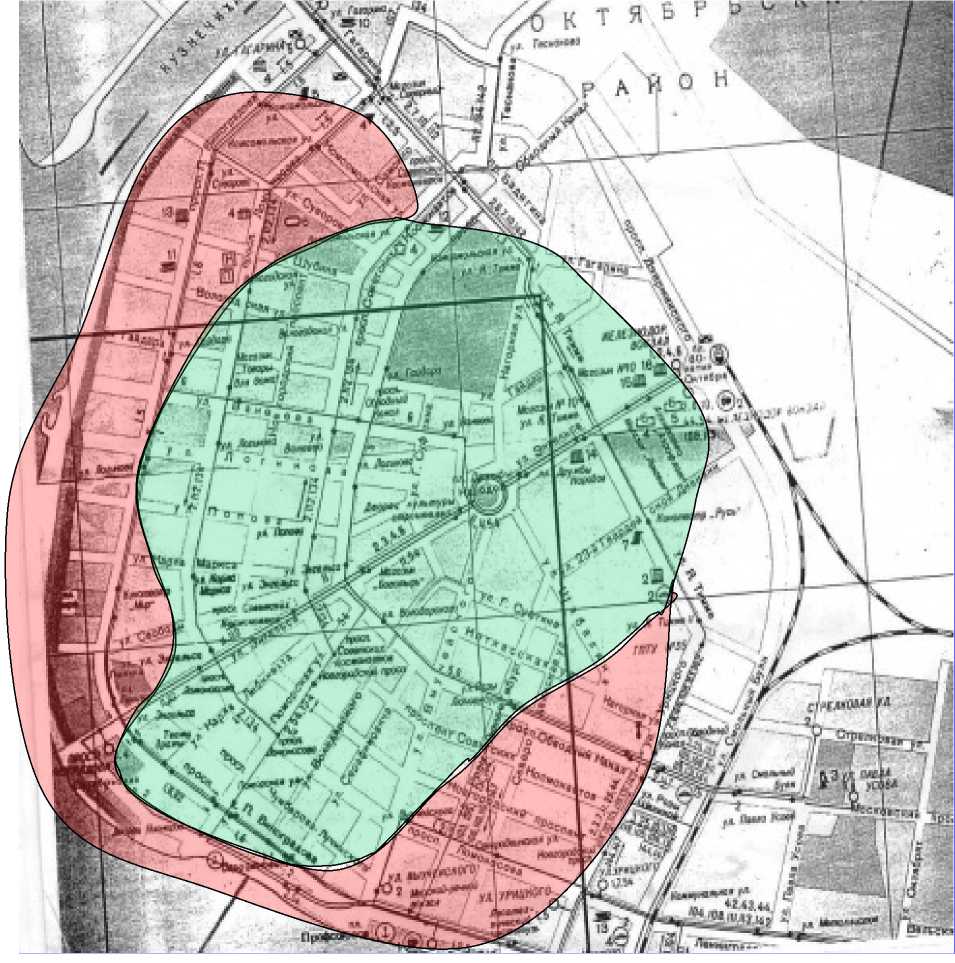
□ > PDK; □ < PDK
Picture 3. The content of total forms of zinc in soils of Arkhangelsk (Zn, mg/kg soils)
In such conditions, increases the solubility of compounds of most TM, and hence increases their migratory ability. In addition, low levels of heavy metals in the upper humus layer and a pref--‐ erential accumulation in the lower levels due to lack of control on the part of tree and shrub forms of vegetation (grass), which prevents the transfer of TM from soils into the ground part of the plant, and then in the upper soil horizons . In this case we can speak about a lesser contrast bio geochemical barrier associated with the formation of biomass. The exception is Zn, the content of which in the upper layer is slightly higher. Unlike other metals, most of it in plants is associated with easy destroyed tissues and rapidly from plant residues.
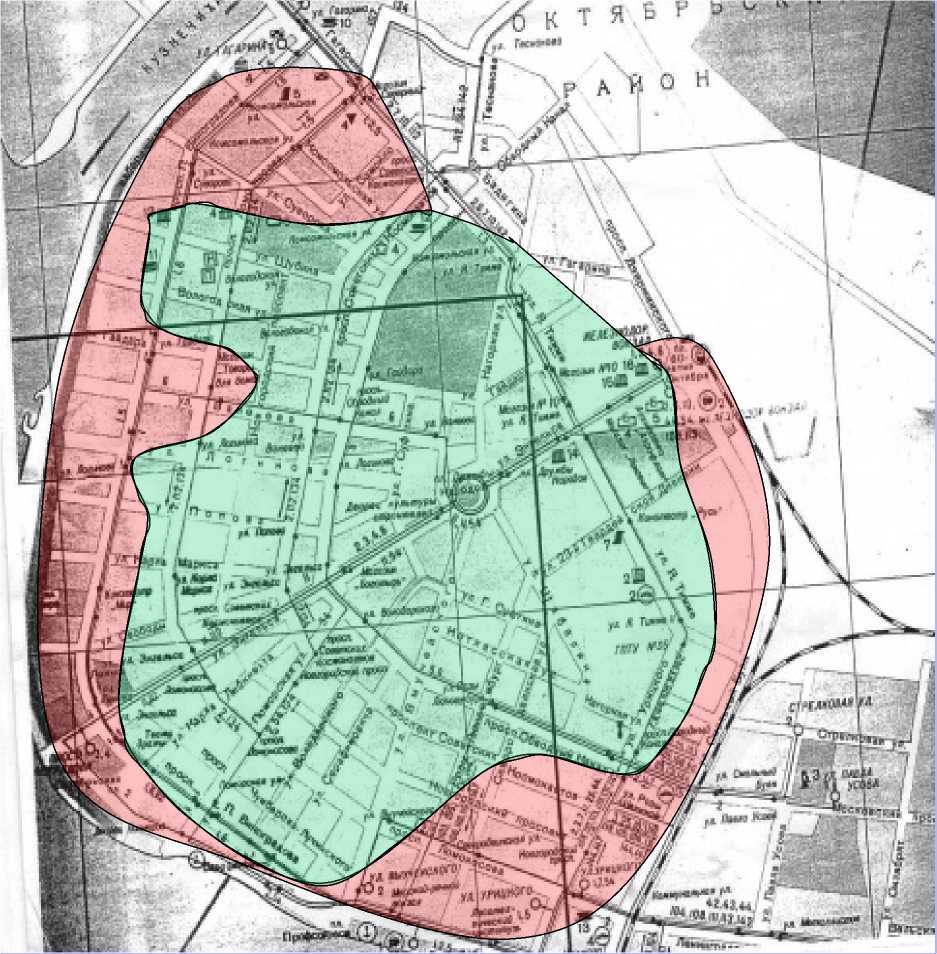
> ПДК; □ < ПДК
Figure 4. The content of total forms of copper in soils of the city of Arkhangelsk (Cu, mg / kg soil)
All soil profiles (natural soil and soil of the city) have a fairly well--‐to--‐mobile Cu, but lower --‐ in other TM, including Zn (Figures 5, 6).
The high content of mobile forms of Cu in urban soils due to the high pH at which the sta--‐ bility of mobile complexes of this element with the organic matter increases. It should be noted that the content of mobile forms of TM in most areas analyzed changes parallel to their total con--‐ centrations. However, in replantozemah compared with other types of urban soils increasing share of mobile Cu and Zn. This points to the dependence of their content on several factors: the degree of formation of soil (accumulation of heavy metals in them occurs over time) and the presence of organic matter (TM form stable complexes with soil humus) and mobile forms of phosphorus, which form insoluble compounds TM.

кг
Horizonts of the soil profiles
|
Natural Soil PP 9 |
Culturozem PP 35 |
Urbanozem PP 61 |
Replantozem PP 44 |
|||||
|
□ |
1 - 2 А Д 2 см |
14,0 ± 0,8 1,40 ± 0,02 |
А 0 - 8 Д 8 см |
39,0 ± 1,1 |
Uha1 4 - 11 7 см |
84,0 ± 1,6 |
Uta2 4 - 17 13 см |
16,0 ± 0,7 |
|
2,10 ± 0,01 |
2,90 ± 0,04 |
2,10 ± 0,01 |
||||||
|
□ |
А 2 - 14 12 см |
15,0 ± 0,2 1,30 ± 0,01 |
А 8 - 30 22 см |
26,0 ± 1,2 |
(Uh+G)a2 11 - 30 19 см |
40,0 ± 1,0 |
Uihsa1 17 - 23 6 см |
6,00 ± 0,03 |
|
1,90 ± 0,02 |
2,10 ± 0,02 |
1,90 ± 0,01 |
||||||
|
□ |
В 14 - 41 27 см |
23,0 ± 1,0 2,00 ± 0,02 |
В 30 - 53 23 см |
14,0 ± 0,9 |
Sha2 от 30 см |
5,03 ± 0,03 |
5,10 ± 0,03 |
|
|
1,00 ± 0,01 |
1,90 ± 0,01 |
Usa2 19 см |
1,30 ± 0,01 |
|||||
|
□ |
ВС 41 - 47 6 см |
71,0 ± 2,3 |
н/д |
н/д |
Sa1 от 42 см |
5,05 ± 0,02 |
||
|
3,50 ± 0,06 |
1,50 ± 0,01 |
|||||||
Note: The columns show the numerator and the total content of copper areas bounded by a broken line, and the de--‐ nominator --‐ the content of mobile forms of copper.
Figure 5. Distribution of total and mobile forms of copper (Cu, mg / kg) on the profile of different soil types in Arkhan--‐ gelsk
The content of the heavy metalls «soil – plant»
To identify the characteristics of HM accumulation in plants of Arkhangelsk and its suburbs were studied content Cu, Zn, Pb, Ni, Co, Fe in the plant material (the photosynthetic parts): above--‐ ground parts of herbaceous vegetation, leaves, shrubs (willow), and trees (poplar and birch).
The results showed that the grasses, leaves, willow, birch and poplar trees in the city to contain high concentrations of TM (Table 3). The leaves of the trees and above--‐ground parts of herbs in the wild, and in the accumulation of a number of TM as follows: Ni For comparing the degree of accumulation of TM plants and natural habitats was calculat--‐ ed concentration ratio (Rk) for birch leaves and ground part of herbs. In urban settings, birch leaves actively accumulate Pb, Ni, Zn and Cu, and in the above--‐ground parts of grasses rapidly ac--‐ cumulate Fe, Co, Ni, and Zn compared to plants suburb (Figure 7). Increased biopogloschenie Zn and Ni biohpility, namely due to the data elements and barrier--‐free nature of their absorption of most plant species. Zn (подвижная форма) мг/кг Natural Soil PP 9 Culturozem PP 35 Urbanozem PP 61 Replantozem PP 44 □ А 1-2 Д 2см 73,0 ± 1,4 4,60 ± 0,02 А 0-8 Д 8 см 770,0 ± 2,3 Uha1 4-11 7см 202,0 ± 2,1 4 -17 47,0 ± 0,9 17,81 ± 1,02 7,80 ± 0,30 Uta2 13см 10,15 ± 0,40 □ 2-14 1 12см 65,2 ± 1,0 А1 8-30 22см 178,0 ± 1,9 (Uh+G)a2 11-30 19см 113,3 ± 1,6 Uihsa1 17-23 6 см 24,0 ± 0,8 3,10 ± 0,02 15,63 ± 1,10 7,17 ± 0,31 13,00 ± 0,60 □ В 14- 41 27см 71,2± 1,0 2,30 ± 0,01 В 30-53 23см 138,0 ± 1,4 Sha2 от 30 см 14,3 ± 0,9 Usa2 23-42 19см 18,0 ± 0,8 13,20 ± 0,90 4,82 ± 0,10 9,52 ± 0,11 □ ВС 41-47 6см 66,0 ± 1,1 н/д н/д Sa1 от 42 см 10,2 ± 0,8 1,91 ± 0,01 3,50 ± 0,08 Note: The columns show the numerator and the total content of zinc, areas bounded by a broken line, and the de--‐ nominator --‐ the content of mobile forms of zinc. Figure 6. Distribution of total and mobile forms of zinc (Zn, mg / kg) on the profile of different soil types in Arkhangelsk It should be noted that the content of heavy metals in the green parts of the plant in Ar--‐ khangelsk not exceed the MPC, which are, according to different authors, for Cu --‐ 15--‐30 mg / kg for Zn --‐ 150--‐300 mg / kg for Ni --‐ 0,5 --‐3 mg / kg for Pb --‐ 0,2--‐20 mg / kg [9, 1998, 13, 1985]. Excep--‐ tion of poplar leaves that accumulate some more Cu. Actively accumulated poplar and Zn, that is, this species is most effectively performed among cleansing functions. On receipt of the TM plants significantly affect particle size, soil humus status and degree of formation. Thus, the content of Fe and Zn neodymium identically in photosynthetic organs of plants in different types of urban soils. Herbaceous vegetation in the intensity of accumulation of these metals can be arranged in the following series of soil types: kulturozem Paul) on different soil types differ slightly. Table 3 HM content (mg / kg) in the leaves of trees and above--‐ground parts of grasses Plants Химический элемент Cu Zn Ni Fe Co Pb Urbant environment Motley grass 11,2 ± 1,1 116,6 ± 22,1 0,74 ± 0,14 94,9 ± 63,5 3,40 ± 0,82 1,6 ± 0,4 willow 11,0 ± 1,7 88,7 ± 10,6 0,90 ± 0,35 122,4 ± 74,6 2,72 ± 0,76 3,4 ± 1,2 birch 10,8 ± 2,4 121,7 ± 39,9 0,73 ± 0,35 24,1 ± 9,3 1,54 ± 0,27 2,9 ± 1,2 poplar Birchm according to 33,2 ± 6,3 250,1 ± 119,2 0,27 ± 0,14 92,8 ± 54,8 2,40 ± 0,55 1,7 ± 0,5 the data of 6,0 - 2,7 282,0 - 4,5 T.A.Guriev, (1996) Poplar, according to a data of M.D. Yfim--‐ zev (2005) 28,39 146,32 4,91 418,33 - 8,78 Chemical Element Растение Cu Zn Ni Fe Co Pb Natural Environment Motley grass 9,2 ± 2,1 24,3 ± 13,6 0,075 ± 0,026 22,6 ± 4,5 0,74 ± 0,23 0,78 ± 0,15 Birch 0,63 ± 0,35 12,8 ± 9,1 0,12 ± 0,05 20,7 ± 11,5 0,90 ± 0,36 0,84 ± 0,36 Figure 7. Concentration ratio (Rk) TM for herbaceous vegetation and birch leaves in Arkhangelsk (Кк) The main source of the trace element composition of plants is the stock exchange forms of heavy metals in the soil. Therefore, to estimate the intensity of the absorption of TM municipal plants was selected biogeochemical absorption coefficient (PCU).. The intensity of the pollution affects accumulation in leaves of Pb, Cu and Zn. Thus, the av--‐ erage CPP for Pb birch leaves in the wild is 0,48, Cu --‐ 0,45, Zn --‐ 2,79, and in the intensity of the ab--‐ sorption of these metals is increased by 3--‐5, 6--‐8 and 1.3 --‐ 2 times respectively. The storage capaci--‐ ty relative to Pb, Cu and Zn in leaves of trees in all the studied soils decreases in the series: Poplar> Birch> willow. On the intensity of absorption of Fe studied tree species form a series: Poplar> Wil--‐ low> birch. Of accumulation of Ni and Co in the leaves of the trees studied depends on the type of soil in which they are growing (Table 4). The intensity of the absorption of TM photosynthetic organs of plants in often greatly re--‐ duced or increased in comparison to natural habitat conditions. TM on the intensity of their absorption by vegetation in the wild can be arranged in as--‐ cending order: Fe Biogeochemical absorption coefficients of TM for grass and leaves of trees Table 4 Pb Cu Zn Fe* Ni Co Natural Soil Motley grass 0,55 7,36 6,1 1,79 0,38 1,85 Birch culturozem 0,48 0,45 2,79 1,64 1,2 2,25 Motley grass 0,76 5,76 8,44 2,23 0,38 1,43 Poplar Urbanozem 2,36 7,5 11,39 2,66 1,11 1,38 Motley grass 1,92 3,84 8,71 4,54 0,58 2,25 Willow 2,15 3,24 4,53 1,5 0,75 1,1 Birch 2,3 3,52 5,77 1,16 0,54 1,64 Poplar Replantozem 2,31 5,12 14,90 1,69 1,67 2,00 Motley grass 1,78 3,48 7,60 11,34 0,96 3,66 Willow 2,34 2,67 3,27 9,79 0,79 2,1 Birch 1,71 2,87 3,70 9,70 0,90 1,25 Poplar According to 2,36 4,77 4,06 10,20 1,24 1,67 the data of O.N. Gordeeva (2006) 2,3 1,7 7,0 - 1,5 2,1 Addition: * - n ⋅ 10--‐3. The intensity of the absorption of iron (Fe) depends on the type of soil on which grow woody plants. Replantozemah on this element accumulates the most studied of all the leaves of trees, and on kulturozemah urbanozem and the magnitude of its PMA similar to those on natural soil and depends on the plant species. Conclusions The research works have shown that the soils of Arkhangelsk characterized polyelement pollution. Residential landscapeof the soil contain large amounts of TM than natural soil. Qualita--‐ tive and quantitative characteristics of the soil contamination TM depend on the type, size distri--‐ bution and degree of development. The greatest pollution of urban soils gross forms of Pb, Cu and Zn observed in the old part of the city of Arkhangelsk, and related to the type of underlying soils. Archangel soils have high security mobile forms of Cu and Zn, but are short of actual reserves Co, Ni and Mn. TM mobility depends on the type of soil --‐ replantozemy have the highest values of mo--‐ bility (R), kulturozemy --‐ the least. Distribution of total and mobile forms of heavy metals in the soil profile usually has the humus--‐accumulative, ie, that their migration is limited sorption biogeochemical barrier. Degree of mobility of heavy metals in soil profiles of different types varies: replantozemy (poorly formed soils light granulometric composition) contain much larger quantities of mobile forms of heavy metals in comparison with most formed and humus and urbanozem kulturozemami. Accumulation of heavy metals in photosynthetic organs of plants irrespective of growth conditions (soil type) occurs in a number of Fe Accumulation TM plants depends on the soil type and content of the actual stock of these items. On replantozemah containing more mobile forms of Cu, Zn, green parts of plants accumu--‐ late in large quantities, and on kulturozemah --‐ the least. Zn and Cu accumulation by plants de--‐ pends on their type. These elements are taken up over the leaves of poplar. Accumulation TM plants depends on grain size and degree of development of soils. In the absence of contrast sorption barriers on soils of light granulometric composition (replantozemy) woody vegetation accumulates the maximum amount of pollutants. The research of the content and migration of heavy metals in soil and vegetation residen--‐ tial landscape of the city of Arkhangelsk can provide preliminary recommendations for the maintenance and improvement of their quality: - It is necessary to organize in the city the monitoring conditions of the soil as the main underly--‐ ing components of ecosystems; - It is necessary to pay more attention to the selection of the range of plants used in a formal landscaping, according to their biological and ecological characteristics, resistance to environ--‐ mental contamination and the mechanisms of the changed conditions in the natural and man--‐ made complex urboecosystems.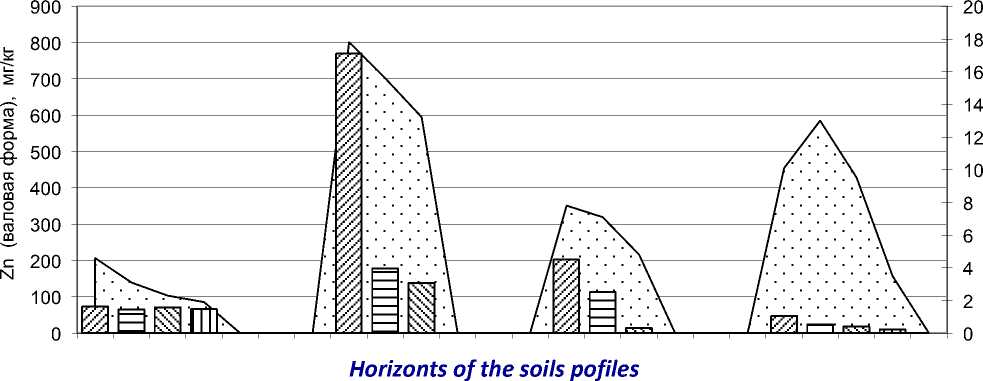

Список литературы Heavy metals in the soil-vegetation cover of the selitebnii landscape of the city Arkhangelsk
- Gordeeva O.N. Nutrients in soil and plants of the technogenic and fone landscapes of the southern Angara / / Problems of sustainability of aquatic and terrestrial ecosystems: Math. IU. Scientific. Conf. (October 912, 2006, RostovonDon). RostovonDon, 2006. Pp. 8890.
- Standard 17.4.4.0284 "protection. Soil. Methods of selection and preparation of soil for chemical, biological and Helminthological analysis. «Standard Resolution of the USSR from 19.12.1984 № 4731.
- Mazhaysky A., Torbat SA, Dubenok NN Agroecology technologically contaminated areas. Smolensk, 2003. 384 p.
- Nevzorov A.L. Features of interaction of the technosphere and subsurface of the Arkhangelsk/ / Pomorye in the Barents region at the turn of the century: ecology, economy, culture tour: Math. International Conf. Arkhangelsk, 2000. Pp. 164165.
- Nikitin A.V. The software of the Geotechnical design of urban infrastructure in the peaty grounds: Author. dis. Candidate. tech. Science. Perm, 2006. 23p.
- Overview of environmental pollution in the Russian Federation for 1997. MEP // Green World. 1998. Number 20. Special Issue. 30p.
- Approximately permissible concentration (APC) heavy metals and arsenic in soils (Appendix № 1 to the list of MPC and APC № 622991): Health standards. M.: Information and Publishing Center State Commission of Russia. 8p.
- Plyaskin O.V. The Features of heavy metal contamination of urban soils in the SouthEastern Administrative District of Moscow: Author. dis. Candidate. b. n. M., 2007. 26p.
- Prokhorov N.V., N.M. Matveev, V.A. Pavlovsky Accumulation of heavy metals in the wild growing and cultivated plants in the foreststeppe and steppe Volga. Samara: Samara. un.t, 1998. 97p.
- Saet E., Revich BA Yanin EP Environmental Geochemistry. Nedra, 1990. 335p.
- Stroganoff M.N., Myagkova A.D., Prokofiev TV. The urban soils: genesis, classification of the functions / / Soil, city, environment [Ed. GV Dobrovolsky]. New York: Foundation "For environmental awareness", 1997. Pp. 1588.
- Ufimtseva M.D., Terekhina N.V. Phytoindication ecological status urbogeositems of St. Petersburg. SPb.: Nauka, 2005. 339 p.

